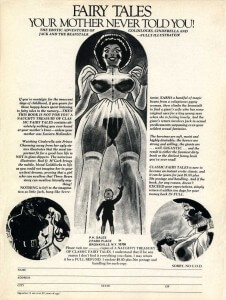People have been writing about sex since they have been writing. Often they had to do this underground or in exile. Many books have misleading title pages, stating the book was published in Paris (where it was often legal) or simply saying “Private, for subscribers” which was also a away around the censorship laws. Sometimes books were masked as anthropological or scientific work. Often books were banned and publishers went to jail. Each work of erotica that survived is a part of a much neglected (and often shunned) history. Our collection spans the mere “bawdy” to the sexually explicit both in literature and in the artwork that accompanied that literature. We also have sexology studies into the “exotic” and “perverse” sexual practices around the world often presented in an intentionally salacious way.
-
Out of stock

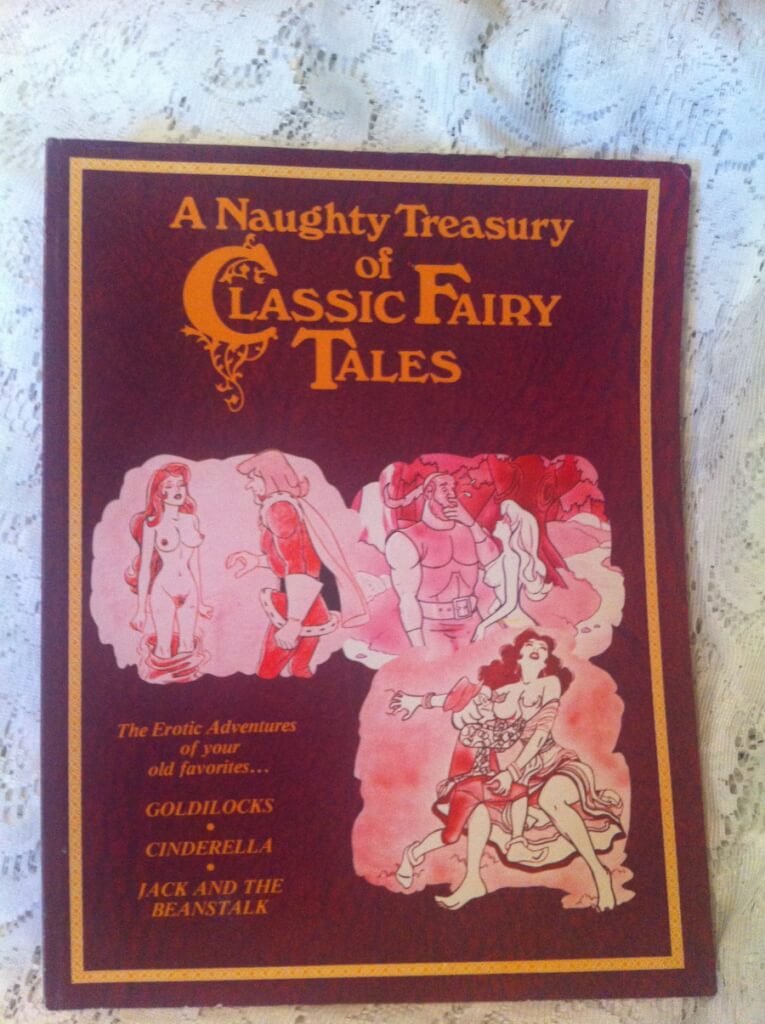 Naughty Treasury of Classic Fairy Tales, "Translated from the Old Saxon and Illustrated by Sir Rod Q. M'Gurk, Knight of the Brush (np, nd c. 1975) 8.5"x11", 96pp (unpaginated), soft covers, good condition, some minor bumping to corners, near fine internal pages I've been able to find a few references to this book and very little about "Sir Rod Q. M'Gurk". He apparently also had his cartoons published in Swank magazine c. 1976-7. Eventually it came to the attention of some illustrators and (with help of former Disney animators) was made into a movie by Don Jurwich (not sure the connection between him and Sir Rod Q. M'Gurk, but I'd love to know if it was him).
Naughty Treasury of Classic Fairy Tales, "Translated from the Old Saxon and Illustrated by Sir Rod Q. M'Gurk, Knight of the Brush (np, nd c. 1975) 8.5"x11", 96pp (unpaginated), soft covers, good condition, some minor bumping to corners, near fine internal pages I've been able to find a few references to this book and very little about "Sir Rod Q. M'Gurk". He apparently also had his cartoons published in Swank magazine c. 1976-7. Eventually it came to the attention of some illustrators and (with help of former Disney animators) was made into a movie by Don Jurwich (not sure the connection between him and Sir Rod Q. M'Gurk, but I'd love to know if it was him). -
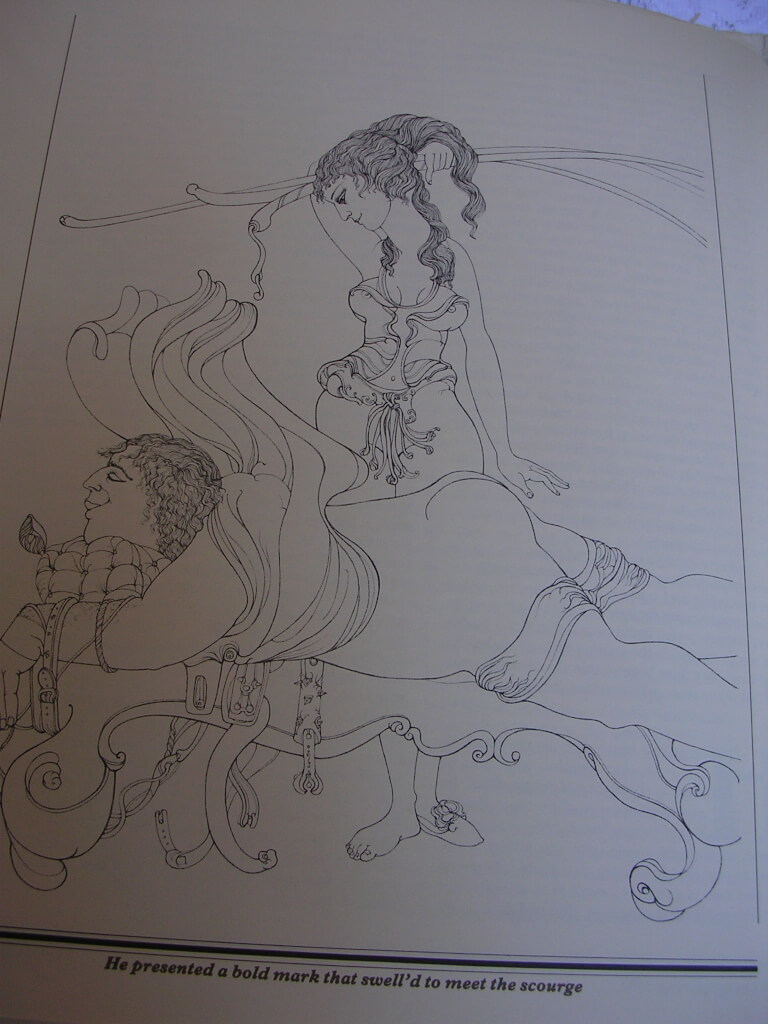
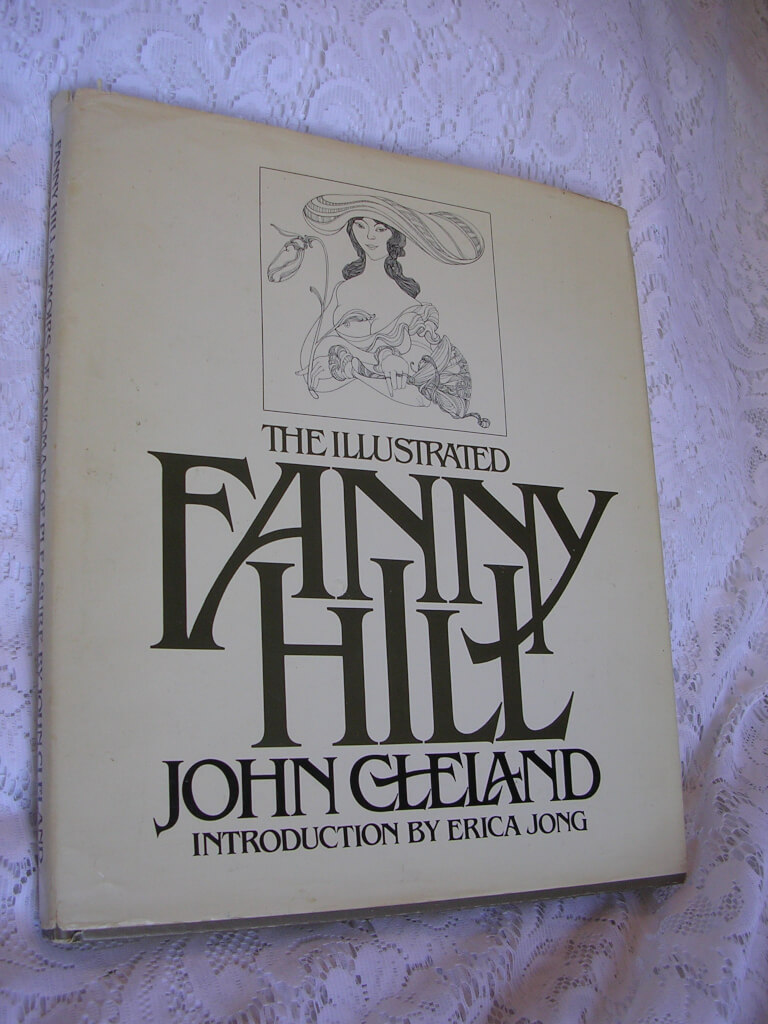 The Illustrated Fanny Hill, John Cleland, illustrated by Zevi Blum, introduction written by Erica Jong, designed by Herb Lubalin (The Erotic Artbook Society [Ralph Ginzburg], 1978, first edition thus, stated "NE PLUS EDITION") 12.5" X 10.5", 127pp, hardbound with DJ, very good condition, minor tears to dust jacket Written while the author was in debtor's prison in London and first published in 1748, Fanny Hill is considered the first original English prose pornography, and the first pornography to use the form of the novel. One of the most prosecuted and banned books in history, it has become a synonym for obscenity. Dust Jacket shows some wear but in good condition. This copy is an excellent and beautiful "legal" (meaning post-1966 Supreme Court Case) edition of Fanny Hill. It was published by Ralph Ginzburg (Eros Magazine, Fact Magazine, served 8 months of a 5 year prison term for obscenity). The illustrations are beautifully done and have a psychedelic feel to them.
The Illustrated Fanny Hill, John Cleland, illustrated by Zevi Blum, introduction written by Erica Jong, designed by Herb Lubalin (The Erotic Artbook Society [Ralph Ginzburg], 1978, first edition thus, stated "NE PLUS EDITION") 12.5" X 10.5", 127pp, hardbound with DJ, very good condition, minor tears to dust jacket Written while the author was in debtor's prison in London and first published in 1748, Fanny Hill is considered the first original English prose pornography, and the first pornography to use the form of the novel. One of the most prosecuted and banned books in history, it has become a synonym for obscenity. Dust Jacket shows some wear but in good condition. This copy is an excellent and beautiful "legal" (meaning post-1966 Supreme Court Case) edition of Fanny Hill. It was published by Ralph Ginzburg (Eros Magazine, Fact Magazine, served 8 months of a 5 year prison term for obscenity). The illustrations are beautifully done and have a psychedelic feel to them. -
Out of stock
 Memoirs of Cardinal Dubois | translated from the French by Ernest Dowson | with photogravure portraits of Cardinal Dubois and the Duc d'Orleans (Leonard Smithers and Co, London, 1899, First Edition thus, first English translation) 9.75"x6.5", 2 volumes, xvi-282pp, viii-268pp, blue boards with gilt decoration and titles on spine, deckled edges, good condition, bumping to corners, bookplates for Reginald Dalton Pontifex in both volumes. According to the publisher, the original manuscript which was written entirely in Dubois hand was stolen by his secretary Lavergne after his death in 1723. It was later discovered of its literary value that Lavergne attempted to sell the manuscript. He was found and arrested. They later fell into the hands of Comte de Maurepas, then upon his death they were passed on to an anonymous writer named Mercier (possibly M. Paul Laroix) whose family had it published in 1829. The manuscript then became lost. In 1899 and English version of the book translated by Ernest Christopher Dowson, was published by the notorious pornographer, Leonard Smithers & Co. This is, presumably a reprinting of that translation. Guillaume Dubois (1656-1723), a son of a country doctor, rose from humble beginnings to positions of power and high honor in government and in the Catholic Church. He is best known for negotiating the Triple Alliance of 1717 between France, the Dutch Republic and Great Britain against their mutual enemy, Spain. Considered one of the four great French Cardinal-Ministers (Richelieu, Mazarin, Dubois, and Fleury). His ecclesiastical career left a great deal to be desired. Although there is no proof of the prevalent assertion that he got secretly married, his licentiousness, and notorious impiety, even at the time of his death, make it evident that he pursued and used ecclesiastical dignities principally to enhance his political position and prestige. Eventually in 1721, Du Bois was created cardinal. He had the reputation of a libertine and adventurer and made plenty of enemies. One of his rivals was charged at creating his portrait, the Duc de Saint-Simon, who was said to have placed a painting of Dubois in his lavatory. Saint-Simon had this to say about the Cardinal: "He was a little, pitiful, wizened, herring-gutted man, in a flaxen wig, with a weasel's face, brightened by some intellect. All the vices - perfidy, avarice, debauchery, ambition, flattery - fought within him for the mastery. He was so consummate a liar that, when taken in the fact, he could brazenly deny it. Even his wit and knowledge of the world were spoiled, and his affected gaiety was touched with sadness, by the odour of falsehood which escaped through every pore of his body." This famous picture is certainly biased. Dubois was unscrupulous, but so were his contemporaries, and whatever vices he had, he forged a European peace that, with the exception of small, restrained military expeditions against the Austrian Habsburgs, would last for a quarter of a century. Leonard Smithers (1861-1907), a solicitor born in Sheffield, was one of the most notable publishers of erotica of his day. He was said to be a brilliant but shady character who operated on the fringes of the rare book trade, issuing small, clandestine editions of risqué books with the boast: 'I will publish the things the others are afraid to touch'. He was notorious for posting a slogan at his bookshop in Bond Street reading "Smut is cheap today". He developed a friendship with Sir Richard Francis Burton and published Burton's famous translation of the Book of One Thousand and One Nights in 1885. He also worked with, among others, Aubrey Beardsley, Aleister Crowley, and Oscar Wilde. With Beardsley and Arthur Symons, he founded The Savoy, a periodical which ran for eight issues in 1896. Smithers famously partnered with Harry Nichols to publish a series of pornographic books under the Erotika Biblion Society imprint. When Beardsley, on his death bed, converted to Catholicism and asked Smithers to “destroy all copies of Lysistrata and bad drawings...by all that is holy all obscene drawings.", Smithers, famously and thankfully ignored him and continued to publish his works until his death in 1907. It was Smithers who published Oscar Wilde's The Ballad of Reading Gaol, a long poem commemorating the harsh rhythms of prison life in 1898. Smithers went bankrupt in 1900 and died impoverished in 1907 from cirrhosis of the liver. Up until his death he continued to sell reproductions (and forgeries) of Beardsley's work as well as reproductions of the Beardsley's letter asking him to destroy his drawings. Reginald Dalton Pontifex (1857–1951) was born in France, attended Magdalen College at Oxford from 1876–80, getting a Fourth in Law in 1880 and a Third in his BCL in 1882. He later practiced as a barrister. At the time of his death it was said he had quite the book collection containing, several of antiquarian interest. He bequethed his book collection to his alma mater. Most of his books were printed in the early nineteenth century and many of them extensively illustrated. He died in Bournemouth, Hampshire, England in 1951.
Memoirs of Cardinal Dubois | translated from the French by Ernest Dowson | with photogravure portraits of Cardinal Dubois and the Duc d'Orleans (Leonard Smithers and Co, London, 1899, First Edition thus, first English translation) 9.75"x6.5", 2 volumes, xvi-282pp, viii-268pp, blue boards with gilt decoration and titles on spine, deckled edges, good condition, bumping to corners, bookplates for Reginald Dalton Pontifex in both volumes. According to the publisher, the original manuscript which was written entirely in Dubois hand was stolen by his secretary Lavergne after his death in 1723. It was later discovered of its literary value that Lavergne attempted to sell the manuscript. He was found and arrested. They later fell into the hands of Comte de Maurepas, then upon his death they were passed on to an anonymous writer named Mercier (possibly M. Paul Laroix) whose family had it published in 1829. The manuscript then became lost. In 1899 and English version of the book translated by Ernest Christopher Dowson, was published by the notorious pornographer, Leonard Smithers & Co. This is, presumably a reprinting of that translation. Guillaume Dubois (1656-1723), a son of a country doctor, rose from humble beginnings to positions of power and high honor in government and in the Catholic Church. He is best known for negotiating the Triple Alliance of 1717 between France, the Dutch Republic and Great Britain against their mutual enemy, Spain. Considered one of the four great French Cardinal-Ministers (Richelieu, Mazarin, Dubois, and Fleury). His ecclesiastical career left a great deal to be desired. Although there is no proof of the prevalent assertion that he got secretly married, his licentiousness, and notorious impiety, even at the time of his death, make it evident that he pursued and used ecclesiastical dignities principally to enhance his political position and prestige. Eventually in 1721, Du Bois was created cardinal. He had the reputation of a libertine and adventurer and made plenty of enemies. One of his rivals was charged at creating his portrait, the Duc de Saint-Simon, who was said to have placed a painting of Dubois in his lavatory. Saint-Simon had this to say about the Cardinal: "He was a little, pitiful, wizened, herring-gutted man, in a flaxen wig, with a weasel's face, brightened by some intellect. All the vices - perfidy, avarice, debauchery, ambition, flattery - fought within him for the mastery. He was so consummate a liar that, when taken in the fact, he could brazenly deny it. Even his wit and knowledge of the world were spoiled, and his affected gaiety was touched with sadness, by the odour of falsehood which escaped through every pore of his body." This famous picture is certainly biased. Dubois was unscrupulous, but so were his contemporaries, and whatever vices he had, he forged a European peace that, with the exception of small, restrained military expeditions against the Austrian Habsburgs, would last for a quarter of a century. Leonard Smithers (1861-1907), a solicitor born in Sheffield, was one of the most notable publishers of erotica of his day. He was said to be a brilliant but shady character who operated on the fringes of the rare book trade, issuing small, clandestine editions of risqué books with the boast: 'I will publish the things the others are afraid to touch'. He was notorious for posting a slogan at his bookshop in Bond Street reading "Smut is cheap today". He developed a friendship with Sir Richard Francis Burton and published Burton's famous translation of the Book of One Thousand and One Nights in 1885. He also worked with, among others, Aubrey Beardsley, Aleister Crowley, and Oscar Wilde. With Beardsley and Arthur Symons, he founded The Savoy, a periodical which ran for eight issues in 1896. Smithers famously partnered with Harry Nichols to publish a series of pornographic books under the Erotika Biblion Society imprint. When Beardsley, on his death bed, converted to Catholicism and asked Smithers to “destroy all copies of Lysistrata and bad drawings...by all that is holy all obscene drawings.", Smithers, famously and thankfully ignored him and continued to publish his works until his death in 1907. It was Smithers who published Oscar Wilde's The Ballad of Reading Gaol, a long poem commemorating the harsh rhythms of prison life in 1898. Smithers went bankrupt in 1900 and died impoverished in 1907 from cirrhosis of the liver. Up until his death he continued to sell reproductions (and forgeries) of Beardsley's work as well as reproductions of the Beardsley's letter asking him to destroy his drawings. Reginald Dalton Pontifex (1857–1951) was born in France, attended Magdalen College at Oxford from 1876–80, getting a Fourth in Law in 1880 and a Third in his BCL in 1882. He later practiced as a barrister. At the time of his death it was said he had quite the book collection containing, several of antiquarian interest. He bequethed his book collection to his alma mater. Most of his books were printed in the early nineteenth century and many of them extensively illustrated. He died in Bournemouth, Hampshire, England in 1951. -
Out of stock
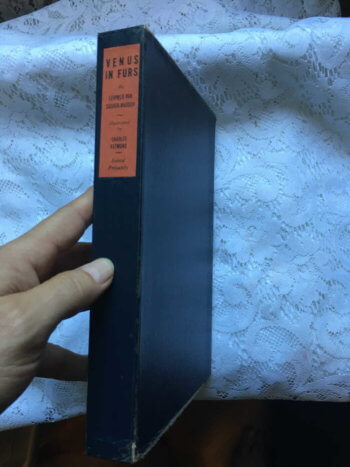
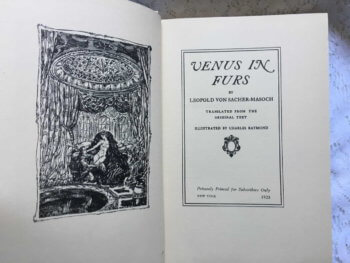 Venus in Furs, Leopold von Sacher-Masoch, illustrated by Charles Raymond [trans. Fernanda Savage] (Privately Printed For Subscribers Only, New York, 1928) 218pp, hardbound with slipcase, blue faux sued boards, white spine with gilt titles, deckled edges, dark blue slipcase with orange title on spine, very good condition for age, slipcase bumps and rubbing repair to bottom of spine, book clean, pages in unread condition with some remaining uncut Venus in Furs (German: Venus im Pelz) is a novella by Leopold Ritter von Sacher-Masoch (1836-1895), an Austrian writer and journalist. It is now his best known work and because of its themes the term masochism is derived from his name, coined by the Austrian psychiatrist, Krafft-Ebing. The novel was to be part of an epic series that Sacher-Masoch envisioned called Legacy of Cain. Venus in Furs was part of Love, the first volume of the series. It was published in 1870. The novel draws themes, like female dominance and sadomasochism, and character inspiration heavily from Sacher-Masoch's own life. Wanda von Dunajew, the novel's central female character, was modelled after his mistress Baroness Fanny Pistor. In December 1869 the two signed a contract making him her slave for a period of 6 months. In 1873, after the publication of Venus in Furs, Sacher-Masoch married Aurora von Rümelin who he pressured to continue the lifestyle he wrote about in his book. After 10 years they divorced. Rümelin, using the pseudonym of the books title character, "Wanda von Dunajew", wrote Meine Lebensbeichte (My Life Confession) published in 1906. It detailed Sacher-Masoch's private life and her relationship with him. During his lifetime, Sacher-Masoch was well known as a man of letters, a utopian thinker who espoused socialist and humanist ideals in his fiction and non-fiction. Most of his works remain untranslated into English. Until recently, his novel Venus in Furs was his only book commonly available in English.
Venus in Furs, Leopold von Sacher-Masoch, illustrated by Charles Raymond [trans. Fernanda Savage] (Privately Printed For Subscribers Only, New York, 1928) 218pp, hardbound with slipcase, blue faux sued boards, white spine with gilt titles, deckled edges, dark blue slipcase with orange title on spine, very good condition for age, slipcase bumps and rubbing repair to bottom of spine, book clean, pages in unread condition with some remaining uncut Venus in Furs (German: Venus im Pelz) is a novella by Leopold Ritter von Sacher-Masoch (1836-1895), an Austrian writer and journalist. It is now his best known work and because of its themes the term masochism is derived from his name, coined by the Austrian psychiatrist, Krafft-Ebing. The novel was to be part of an epic series that Sacher-Masoch envisioned called Legacy of Cain. Venus in Furs was part of Love, the first volume of the series. It was published in 1870. The novel draws themes, like female dominance and sadomasochism, and character inspiration heavily from Sacher-Masoch's own life. Wanda von Dunajew, the novel's central female character, was modelled after his mistress Baroness Fanny Pistor. In December 1869 the two signed a contract making him her slave for a period of 6 months. In 1873, after the publication of Venus in Furs, Sacher-Masoch married Aurora von Rümelin who he pressured to continue the lifestyle he wrote about in his book. After 10 years they divorced. Rümelin, using the pseudonym of the books title character, "Wanda von Dunajew", wrote Meine Lebensbeichte (My Life Confession) published in 1906. It detailed Sacher-Masoch's private life and her relationship with him. During his lifetime, Sacher-Masoch was well known as a man of letters, a utopian thinker who espoused socialist and humanist ideals in his fiction and non-fiction. Most of his works remain untranslated into English. Until recently, his novel Venus in Furs was his only book commonly available in English. -
Out of stock
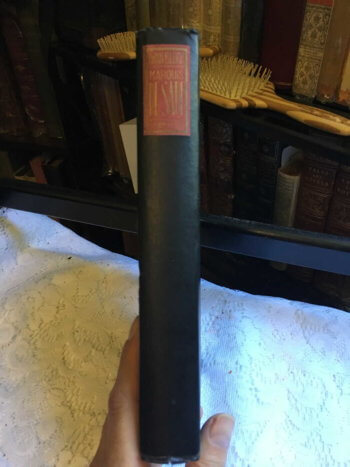
 Marquis de Sade | The Man and His Age | studies in the history of the culture and morals of the eighteenth century, Dr. Iwan Bloch, translated by James Bruce (Julian Press, 1931, [first american edition]) 6 .5"x9.5", 296pp, hardbound, black boards, red and gilt title on spine, some bumps and wear, good condition for age. Iwan Bloch (1872-1922), the “father of sexology”, was a Berlin dermatologist. His many socio-cultural studies in sexology earned him an international reputation as a medical historian. He also discovered de Sade’s manuscript of the “120 days of Sodom” in 1904, which had been believed to be lost. Together with Magnus Hirschfeld and Albert Eulenburg, Bloch proposed the new concept of a science of sexuality: Sexualwissenschaft or sexology. In 1906 he wrote Das Sexualleben unserer Zeit in seinen Beziehungen zur modernen Kultur [The Sexual Life of our Time in its Relations to Modern Civilization], a complete encyclopedia of the sexual sciences in their relation to modern civilization. According to Sigmund Freud, Bloch's studies were instrumental in the development of the anthropological approach to the theory of sexuality. For example, before Bloch, homosexuality was analyzed using a pathological approach.
Marquis de Sade | The Man and His Age | studies in the history of the culture and morals of the eighteenth century, Dr. Iwan Bloch, translated by James Bruce (Julian Press, 1931, [first american edition]) 6 .5"x9.5", 296pp, hardbound, black boards, red and gilt title on spine, some bumps and wear, good condition for age. Iwan Bloch (1872-1922), the “father of sexology”, was a Berlin dermatologist. His many socio-cultural studies in sexology earned him an international reputation as a medical historian. He also discovered de Sade’s manuscript of the “120 days of Sodom” in 1904, which had been believed to be lost. Together with Magnus Hirschfeld and Albert Eulenburg, Bloch proposed the new concept of a science of sexuality: Sexualwissenschaft or sexology. In 1906 he wrote Das Sexualleben unserer Zeit in seinen Beziehungen zur modernen Kultur [The Sexual Life of our Time in its Relations to Modern Civilization], a complete encyclopedia of the sexual sciences in their relation to modern civilization. According to Sigmund Freud, Bloch's studies were instrumental in the development of the anthropological approach to the theory of sexuality. For example, before Bloch, homosexuality was analyzed using a pathological approach. -
Out of stock
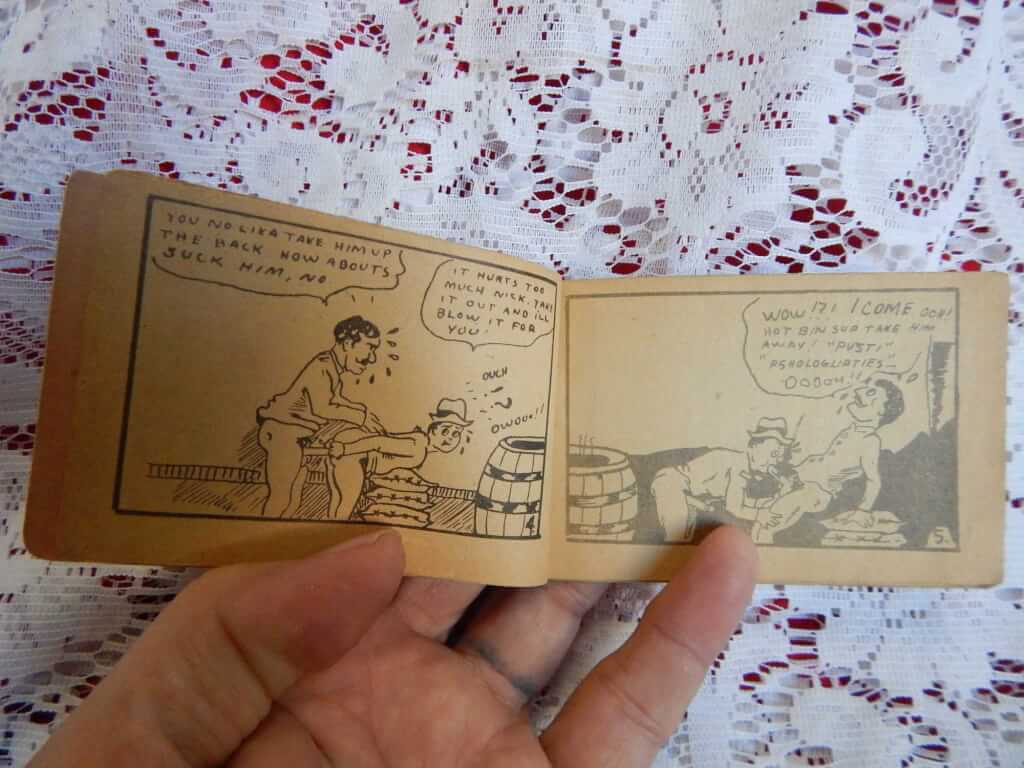
 Harold Teen, (n.p. n.d.) 4.5" x 3", 8pp. pamphlet, stapled Tijuana bibles (also known as eight-pagers, bluesies, gray-backs, Jiggs-and-Maggie books, jo-jo books, Tillie-and-Mac books, and two-by-fours) were little pornographic comic books produced in the United States from the 1920s to the early 1960s.
Harold Teen, (n.p. n.d.) 4.5" x 3", 8pp. pamphlet, stapled Tijuana bibles (also known as eight-pagers, bluesies, gray-backs, Jiggs-and-Maggie books, jo-jo books, Tillie-and-Mac books, and two-by-fours) were little pornographic comic books produced in the United States from the 1920s to the early 1960s. -

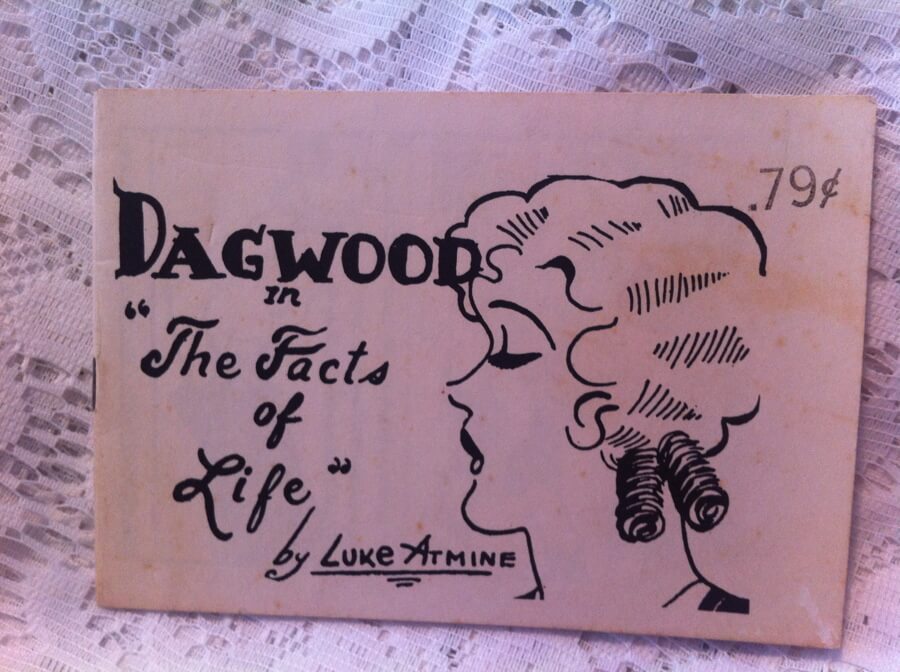 Dagwood in "The Facts of Life" / Boots, by Luke Armine (n.p., n.d.) 5" x 3.5", 8pp. double pamphlet, stapled Tijuana bibles (also known as eight-pagers, bluesies, gray-backs, Jiggs-and-Maggie books, jo-jo books, Tillie-and-Mac books, and two-by-fours) were little pornographic comic books produced in the United States from the 1920s to the early 1960s. This book is two books in one, featuring reprints of the originals printed on both sides of the paper. Flip the book over and it's a different book. "Boots and Her Buddies" was an American comic strip that ran from 1924 to 1969. Some newspapers presented the strip under the shortened title "Boots". The character of Boots was variously labeled the "Sweetheart of the Comics", the "Sweetheart of America" and "Everybody's Sweetheart".
Dagwood in "The Facts of Life" / Boots, by Luke Armine (n.p., n.d.) 5" x 3.5", 8pp. double pamphlet, stapled Tijuana bibles (also known as eight-pagers, bluesies, gray-backs, Jiggs-and-Maggie books, jo-jo books, Tillie-and-Mac books, and two-by-fours) were little pornographic comic books produced in the United States from the 1920s to the early 1960s. This book is two books in one, featuring reprints of the originals printed on both sides of the paper. Flip the book over and it's a different book. "Boots and Her Buddies" was an American comic strip that ran from 1924 to 1969. Some newspapers presented the strip under the shortened title "Boots". The character of Boots was variously labeled the "Sweetheart of the Comics", the "Sweetheart of America" and "Everybody's Sweetheart". -
Out of stock

 The Town Bull: the experiences of a young man before and after his marriage Bob Stirling, (Privately Printed by U. C. M. Fall, London, Paris,nd [false imprint. this is a pamphlet, not the book]) 7.25" x 5.5", 32pp., pamphlet, good condition, some fading Erotic story, no illustrations
The Town Bull: the experiences of a young man before and after his marriage Bob Stirling, (Privately Printed by U. C. M. Fall, London, Paris,nd [false imprint. this is a pamphlet, not the book]) 7.25" x 5.5", 32pp., pamphlet, good condition, some fading Erotic story, no illustrations -
Out of stock
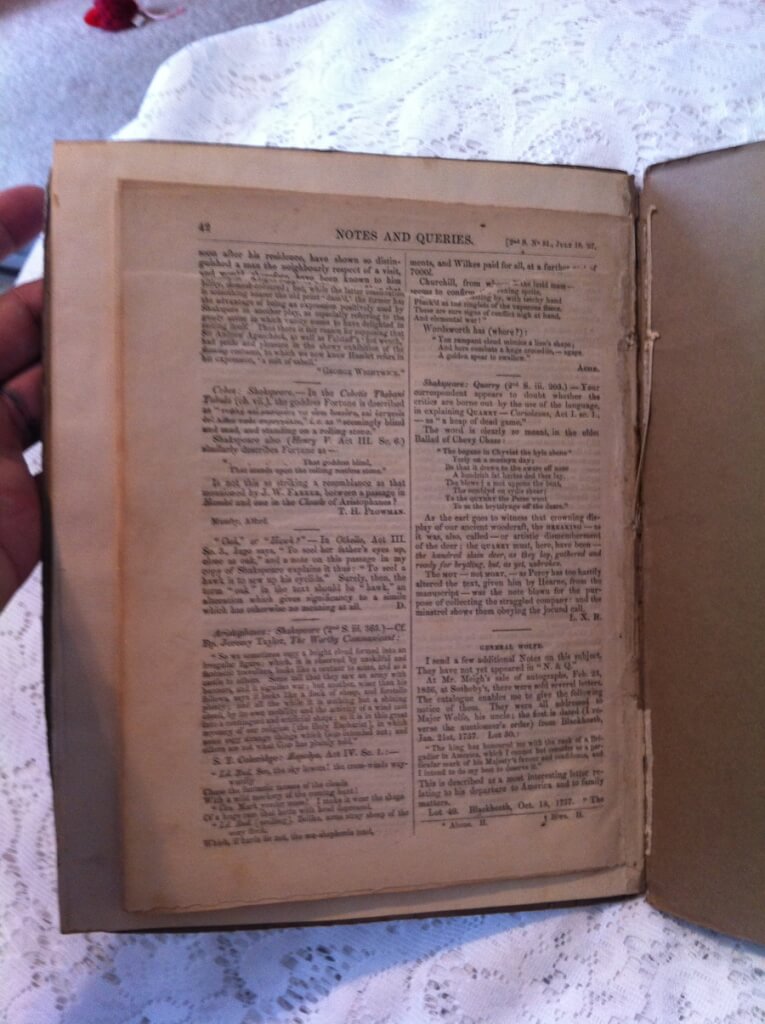
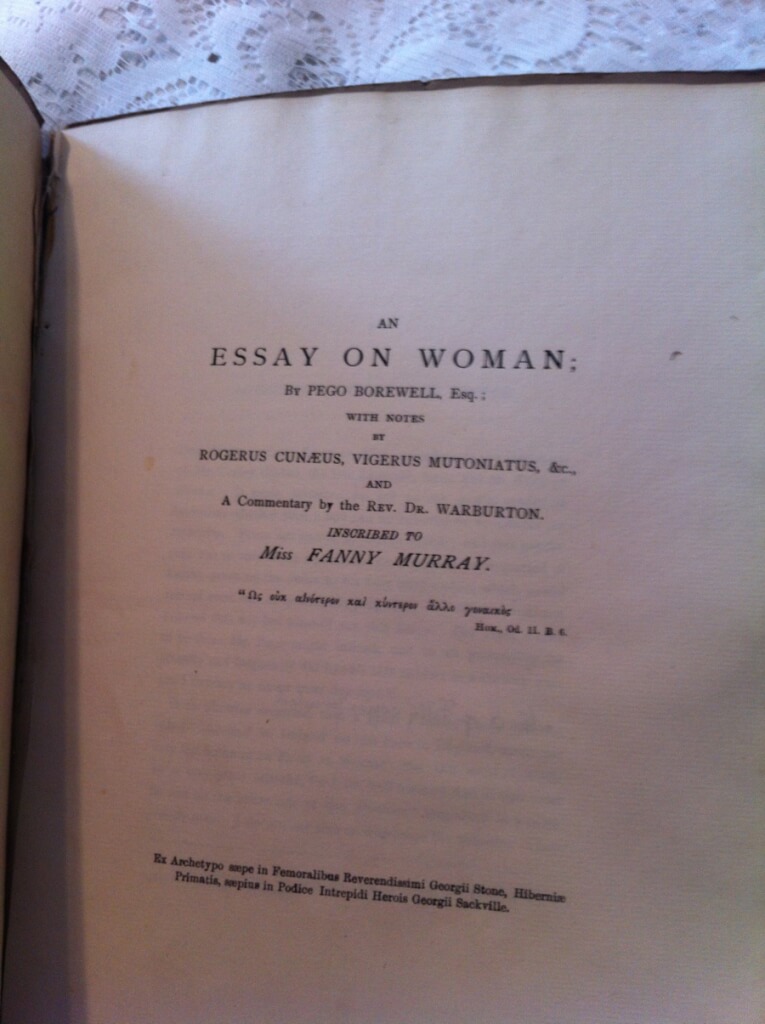 An Essay on Woman, by Pego Borewell, Esq., "with notes by Rogerus Cuneaus, Vigerus Mutoniatus, & Co. and A Commentary by the Rev. Dr. Warburton, inscribed to Miss Fanny Murray (np, bibliography on last page dated 1883) 7.5" X 9.75", 24pp., original soft wraps appear to be enclosed in brown wrap, appear to be two pages cut out before the title page, articles from "Notes and Queries" (dating July 11, 1857 and July 18, 1857) pasted into back of the book, followed by notes on legal paper from previous owner presumably trying to verify this edition Sometime in 1755, John Wilkes, together with fellow rake and son of the Archbishop of Cantebury, Thomas Potter (c. 1718-1759), composed a bawdy set of parodied Alexander Pope poems entitled An Essay on Woman, a satirical imitation of Pope's An Essay on Man. In 1763 he was put in jail for political reasons ("seditious libel for his anti-Jacobite smearing which appeared in his 'radical' weekly publication"). Upon release, his home was unlawfully searched and proofs of his "Essay on Woman" was discovered. This is an unknown reprint, as no original is known. I am still researching.
An Essay on Woman, by Pego Borewell, Esq., "with notes by Rogerus Cuneaus, Vigerus Mutoniatus, & Co. and A Commentary by the Rev. Dr. Warburton, inscribed to Miss Fanny Murray (np, bibliography on last page dated 1883) 7.5" X 9.75", 24pp., original soft wraps appear to be enclosed in brown wrap, appear to be two pages cut out before the title page, articles from "Notes and Queries" (dating July 11, 1857 and July 18, 1857) pasted into back of the book, followed by notes on legal paper from previous owner presumably trying to verify this edition Sometime in 1755, John Wilkes, together with fellow rake and son of the Archbishop of Cantebury, Thomas Potter (c. 1718-1759), composed a bawdy set of parodied Alexander Pope poems entitled An Essay on Woman, a satirical imitation of Pope's An Essay on Man. In 1763 he was put in jail for political reasons ("seditious libel for his anti-Jacobite smearing which appeared in his 'radical' weekly publication"). Upon release, his home was unlawfully searched and proofs of his "Essay on Woman" was discovered. This is an unknown reprint, as no original is known. I am still researching. -
Out of stock
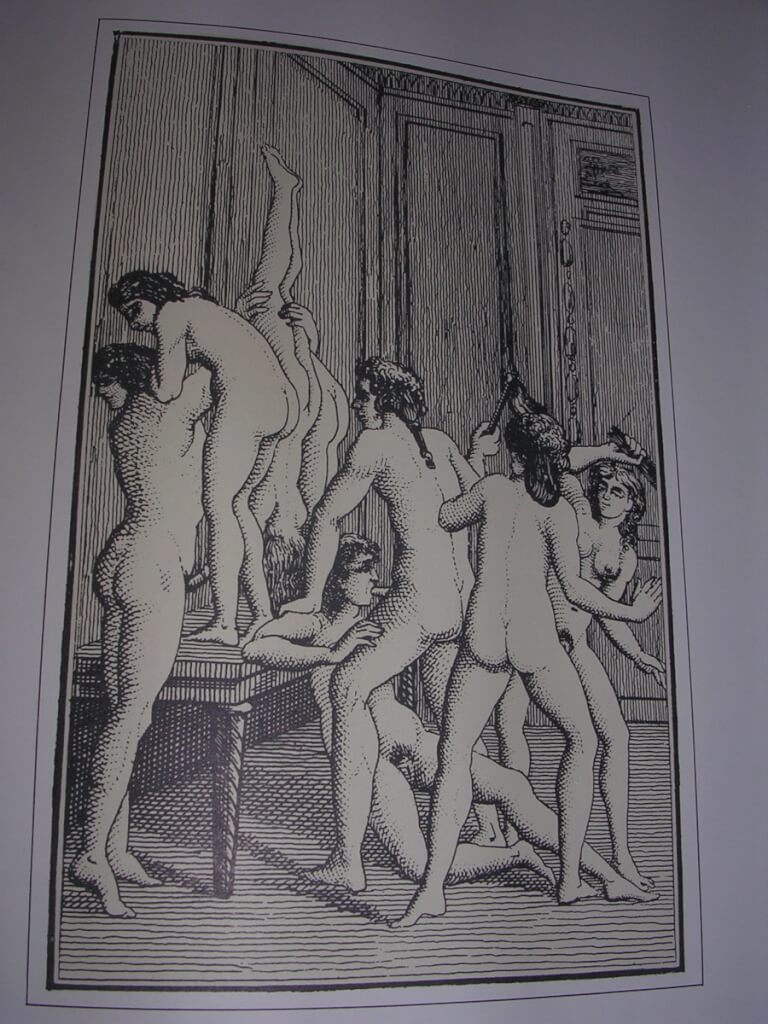
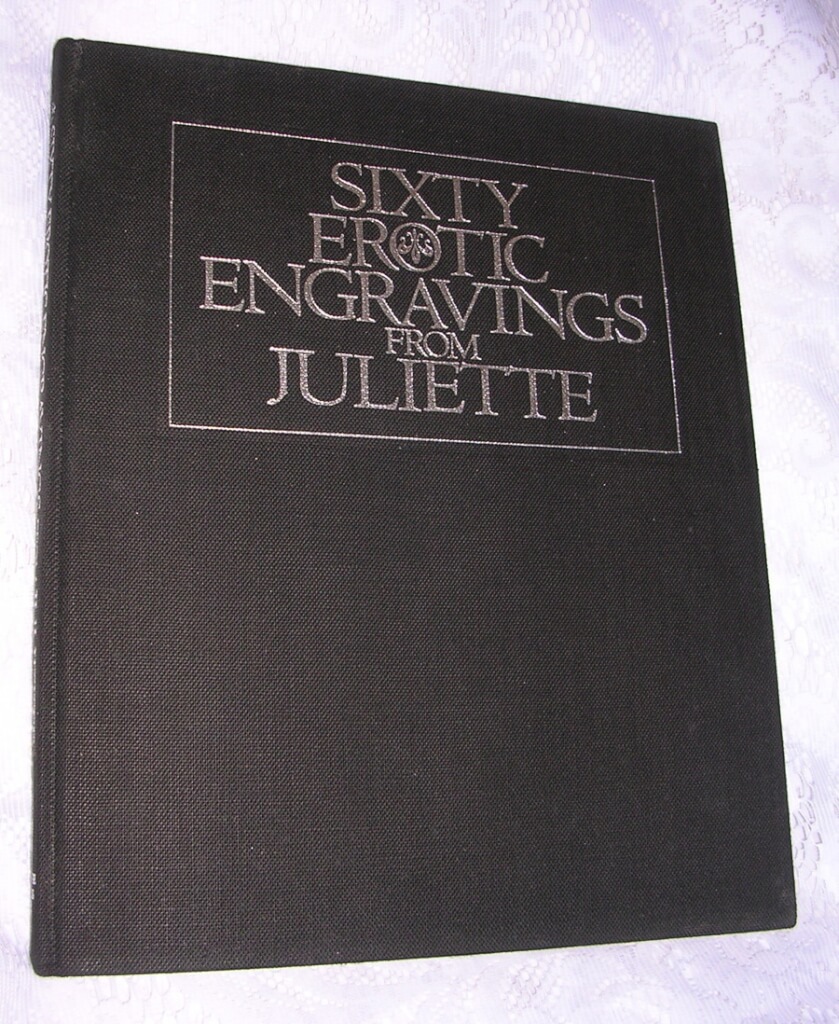 SIXTY EROTIC ENGRAVINGS FROM JULIETTE, Marquise De Sade (Grove Press, Inc., New York, 1969 [first printing]) 11 3/8" X 9 1/2", 60pp, hardback no DJ, good condition 1797 The Marquis de Sade published "Justine, or the Misfortunes of Virtue" and "Juliette or the Prosperity of Vice" (or "vice amply rewarded") together forming 10 volumes of nearly 4000 pages in total; publication was completed in 1801 and included around 100 very explicit engravings. Napoleon Bonaparte ordered the arrest of the anonymous author of Justine and Juliette, and as a result Sade was incarcerated for the last 13 years of his life. Napoleon called the work "the most abominable book ever engendered by the most depraved imagination". Justine and Juliette were published sporadically from the 19th century into the mid 20th century but mostly without any of the engravings from the original. The engravings which appear in this book were reproduced from a copy of that famous 1797 Holland edition. This publication marks the first legal printing of these engravings in the US.
SIXTY EROTIC ENGRAVINGS FROM JULIETTE, Marquise De Sade (Grove Press, Inc., New York, 1969 [first printing]) 11 3/8" X 9 1/2", 60pp, hardback no DJ, good condition 1797 The Marquis de Sade published "Justine, or the Misfortunes of Virtue" and "Juliette or the Prosperity of Vice" (or "vice amply rewarded") together forming 10 volumes of nearly 4000 pages in total; publication was completed in 1801 and included around 100 very explicit engravings. Napoleon Bonaparte ordered the arrest of the anonymous author of Justine and Juliette, and as a result Sade was incarcerated for the last 13 years of his life. Napoleon called the work "the most abominable book ever engendered by the most depraved imagination". Justine and Juliette were published sporadically from the 19th century into the mid 20th century but mostly without any of the engravings from the original. The engravings which appear in this book were reproduced from a copy of that famous 1797 Holland edition. This publication marks the first legal printing of these engravings in the US. -
Out of stock
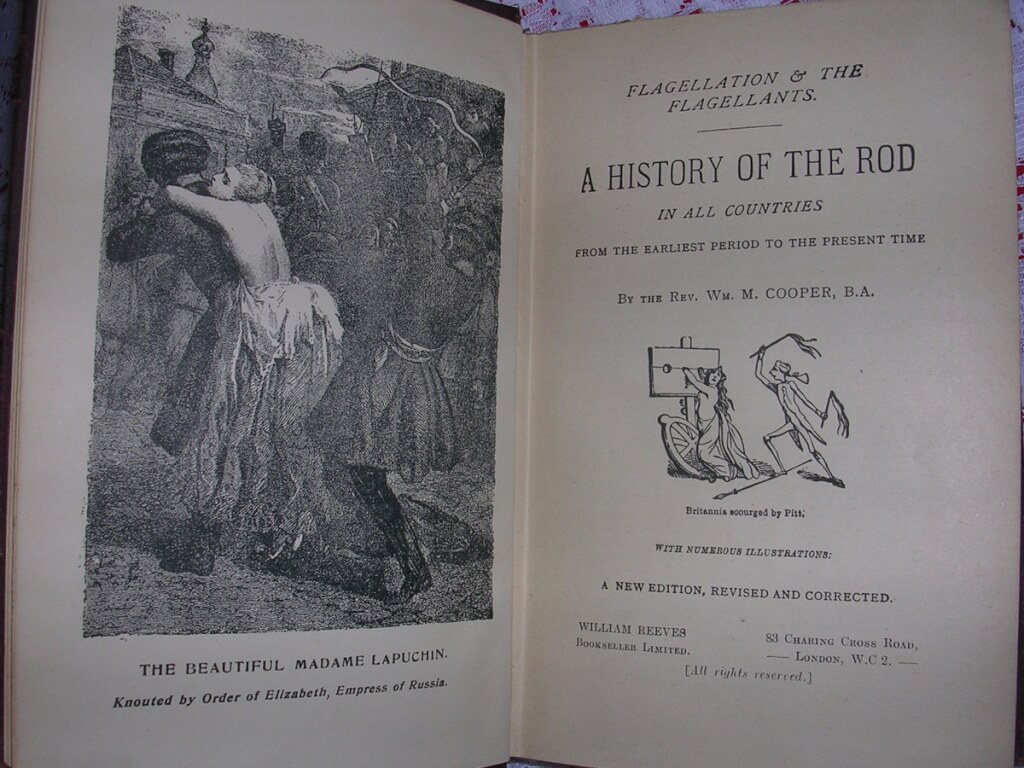
 Flagellation & the Flagellants. A History of the Rod in All Countries from the earliest period to the present time, The Rev. Wm. M. Cooper, B.A. [James Glass Bertram] (William Reeves Bookseller Limited, London, nd [c. 1908]) 7 3/4" X 5 1/4", 544pp, hardbound no DJ, dark purple cloth boards with gilt stamp and blind stamp decorations to boards and spine, good condition, minor bumping and rubbing, a few stains on lower fore-edge of boards. Bertram was apprenticed to Tait's Edinburgh Magazine and became managing clerk, before joining a company of strolling players. He returned to Edinburgh and set up as a bookseller and newsagent. In 1855 he was appointed the editor of the North Briton and in 1872 of the Glasgow News, leaving to become a freelance journalist two years later. He published "flagellation" pornography under the names "Revd William Cooper" and "Margaret Anson". This edition was published by William Reeves sometime around 1908.
Flagellation & the Flagellants. A History of the Rod in All Countries from the earliest period to the present time, The Rev. Wm. M. Cooper, B.A. [James Glass Bertram] (William Reeves Bookseller Limited, London, nd [c. 1908]) 7 3/4" X 5 1/4", 544pp, hardbound no DJ, dark purple cloth boards with gilt stamp and blind stamp decorations to boards and spine, good condition, minor bumping and rubbing, a few stains on lower fore-edge of boards. Bertram was apprenticed to Tait's Edinburgh Magazine and became managing clerk, before joining a company of strolling players. He returned to Edinburgh and set up as a bookseller and newsagent. In 1855 he was appointed the editor of the North Briton and in 1872 of the Glasgow News, leaving to become a freelance journalist two years later. He published "flagellation" pornography under the names "Revd William Cooper" and "Margaret Anson". This edition was published by William Reeves sometime around 1908. -
Out of stock

 The Sex Factor in Marriage: a book for those who are about to be married, Hellen Wright, M.B., B.S., intros by A.Herbert Gray, M.A., D.D., and Abel Gregg, A.B., M.A. (The Vanguard Press, New York, 1937) 7.75" X 5.25", 172pp, hardcover with dust jacket, blue boards, good condition, some small tears in dust jacket. From d.j.: "This book contains very detailed information about the ways in which the physical intimacies of married life may be successfully and happily managed. It is addressed to those about to be married in the hope that it may save them from mistakes and sufferings which have darkened married life for thousands of couples."
The Sex Factor in Marriage: a book for those who are about to be married, Hellen Wright, M.B., B.S., intros by A.Herbert Gray, M.A., D.D., and Abel Gregg, A.B., M.A. (The Vanguard Press, New York, 1937) 7.75" X 5.25", 172pp, hardcover with dust jacket, blue boards, good condition, some small tears in dust jacket. From d.j.: "This book contains very detailed information about the ways in which the physical intimacies of married life may be successfully and happily managed. It is addressed to those about to be married in the hope that it may save them from mistakes and sufferings which have darkened married life for thousands of couples." -
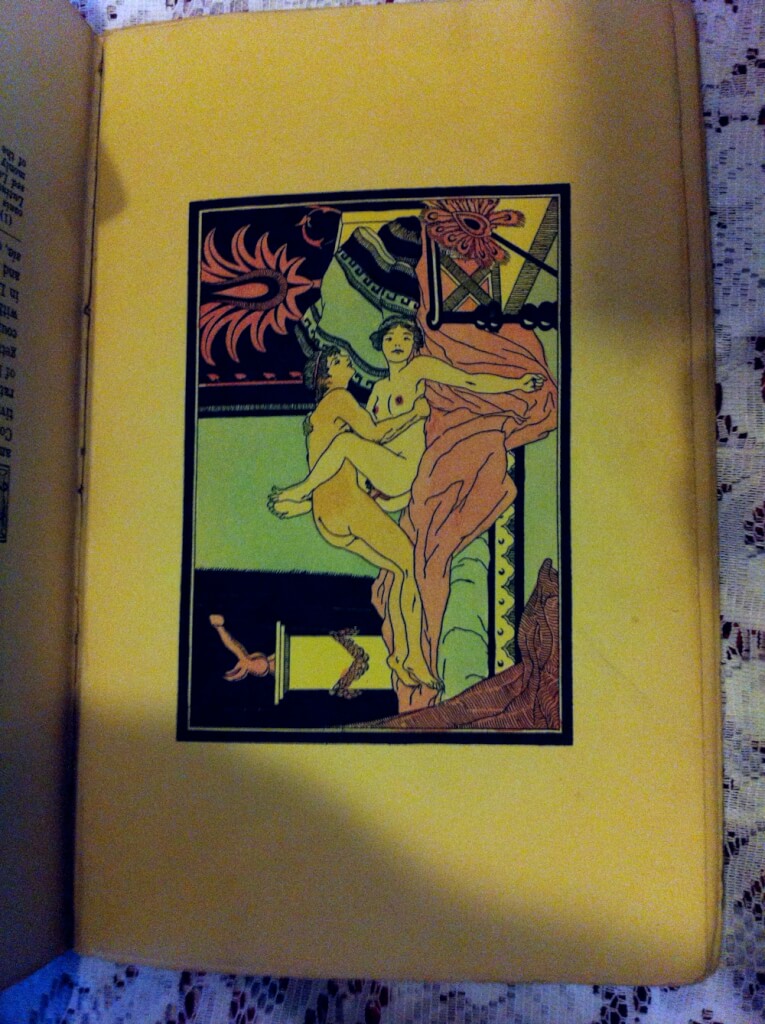
 the Dialogues of Luisa Sigea, Nicolas Chorier (Isadore Liseux, Paris 1890 [most likely an American pirated copy from the 1920-30's] illustrator unknown) 8.75" X 6", xx 296pp., bound in thin green boards and green tape on spine. Fair condition, binding is loose in places, part of first signature taped in place, rips in spine. Explicit color illustrations. Bookplate of Theodor Reich. In six dialogues, Tullia, who is 26, initiates her 15 year old cousin, Ottavia, in the art of sexual pleasure. The first four dialogues, which are fairly short, focus on tribadism and defloration. The longer fifth and six dialogues introduce flagellation, contractual submission, group sex, and anal sex. (I. The skirmish; II. Tribadicon; III. Fabric; IV. The duel; V. Pleasures; VI. Frolics and sports) Like many sexual fictions, The Dialogues of Luisa Sigea attempts to conceal the identity of its author: it purports to be based on a Latin manuscript translation of a work written originally in Spanish in the sixteenth-century by an erudite young woman, Luisa Sigea of Toledo and translated into latin by Jean Meursius of Holland. In fact, it was written c. 1660, in latin, by a Frenchman, Nicolas Chorier (1612-1692), a lawyer who wrote works on various historical and philosophical subjects. The first French translation, L\'Academie des dames, was issued in the 1680. It was first translated into English by Isidore Liseux and issued as a 3 volume set. (1. I-IV, 2. V, 3. VI). This book contains all 6 of the dialogues and some very pornographic colored illustrations.
the Dialogues of Luisa Sigea, Nicolas Chorier (Isadore Liseux, Paris 1890 [most likely an American pirated copy from the 1920-30's] illustrator unknown) 8.75" X 6", xx 296pp., bound in thin green boards and green tape on spine. Fair condition, binding is loose in places, part of first signature taped in place, rips in spine. Explicit color illustrations. Bookplate of Theodor Reich. In six dialogues, Tullia, who is 26, initiates her 15 year old cousin, Ottavia, in the art of sexual pleasure. The first four dialogues, which are fairly short, focus on tribadism and defloration. The longer fifth and six dialogues introduce flagellation, contractual submission, group sex, and anal sex. (I. The skirmish; II. Tribadicon; III. Fabric; IV. The duel; V. Pleasures; VI. Frolics and sports) Like many sexual fictions, The Dialogues of Luisa Sigea attempts to conceal the identity of its author: it purports to be based on a Latin manuscript translation of a work written originally in Spanish in the sixteenth-century by an erudite young woman, Luisa Sigea of Toledo and translated into latin by Jean Meursius of Holland. In fact, it was written c. 1660, in latin, by a Frenchman, Nicolas Chorier (1612-1692), a lawyer who wrote works on various historical and philosophical subjects. The first French translation, L\'Academie des dames, was issued in the 1680. It was first translated into English by Isidore Liseux and issued as a 3 volume set. (1. I-IV, 2. V, 3. VI). This book contains all 6 of the dialogues and some very pornographic colored illustrations. -
 Memoirs of a Woman of Pleasure or The Life of Fanny Hill, John Cleland (Hoboken, np, 1929 [Philadelphia?] limited edition #621/700 first edition) 5 3/4″ X 8 1/4″, 211pp, quarter-bound red cloth over decorated boards, white label affixed to spine, color illustrations (rare) in an “art deco” style in similar to Aubrey Beardsley [or Elliot Dodd], excellent condition for age. Written while the author was in debtor’s prison in London and first published in 1749, Fanny Hill is considered the first original English prose pornography, and the first pornography to use the form of the novel. One of the most prosecuted and banned books in history, it has become a synonym for obscenity. The Hoboken copies of Fanny Hill are quite rare. This is the first edition original published c. 1929 with color illustrations and is extremely rare. An other edition appeared c. 1932 with the illustrations in black and white. It is unknown who the artist is but the illustrations are quite detailed and good.
Memoirs of a Woman of Pleasure or The Life of Fanny Hill, John Cleland (Hoboken, np, 1929 [Philadelphia?] limited edition #621/700 first edition) 5 3/4″ X 8 1/4″, 211pp, quarter-bound red cloth over decorated boards, white label affixed to spine, color illustrations (rare) in an “art deco” style in similar to Aubrey Beardsley [or Elliot Dodd], excellent condition for age. Written while the author was in debtor’s prison in London and first published in 1749, Fanny Hill is considered the first original English prose pornography, and the first pornography to use the form of the novel. One of the most prosecuted and banned books in history, it has become a synonym for obscenity. The Hoboken copies of Fanny Hill are quite rare. This is the first edition original published c. 1929 with color illustrations and is extremely rare. An other edition appeared c. 1932 with the illustrations in black and white. It is unknown who the artist is but the illustrations are quite detailed and good. -
 Fanny Hill's Cook Book, Lionel H. Braun & William Adams, illustrations by Brian Forbes (Taplinger Publishing Co., Inc., New York, 1971 [first edition]) 9 3/8" X 6 1/8", 137pp, hardbound with DJ, good condition, binding tight, some soiling to front boards, few tears in dust jacket Rare and raunchy 70's cookbook. Highlights include "Whores d'oeuvres and snacks" featuring "Dildoughs with Warts in Hot Lips", "Pickled Peckers" and Marquise d'Salade with Crafty Ebbing Undressing". In the "Meat Dishes" section there is "Suc d'Meat", "Rump Roast or Backside Entree", and "Fellatio Mignon". There is a whole section "On Stuffing." The pasta section features "Cunnilinguini with Pietro's Tongue" and the dessert features among others "Jock's Strap", "The Nutcracker Sweet" and "Virgin's pushups with a few bawdy stories thrown in between the recipes. The illustrations are very fun. Very 70's. A good copy of a rare book.
Fanny Hill's Cook Book, Lionel H. Braun & William Adams, illustrations by Brian Forbes (Taplinger Publishing Co., Inc., New York, 1971 [first edition]) 9 3/8" X 6 1/8", 137pp, hardbound with DJ, good condition, binding tight, some soiling to front boards, few tears in dust jacket Rare and raunchy 70's cookbook. Highlights include "Whores d'oeuvres and snacks" featuring "Dildoughs with Warts in Hot Lips", "Pickled Peckers" and Marquise d'Salade with Crafty Ebbing Undressing". In the "Meat Dishes" section there is "Suc d'Meat", "Rump Roast or Backside Entree", and "Fellatio Mignon". There is a whole section "On Stuffing." The pasta section features "Cunnilinguini with Pietro's Tongue" and the dessert features among others "Jock's Strap", "The Nutcracker Sweet" and "Virgin's pushups with a few bawdy stories thrown in between the recipes. The illustrations are very fun. Very 70's. A good copy of a rare book. -
 1601 A Tudor Fireside Conversation As Written by the Ingenuous, Virtuous and learned Mark Twain, wit., Embellished by the worthy Alan Odle, Mark Twain, illustrations Alan Odle (Land's End Press, USA, 1969, stated "At London, Printed for Subscribers Only and are to be sold at ye beare Back-Side in Maiden Lane") 8.75"x11.25", 24pp (unpaginated), hardbound with mylar-protected dust jacket, red boards with gilt titles [Date: 1601.] Conversation, as it was the Social Fireside, in the Time of the Tudors is the title of a humorous work by Mark Twain, first published anonymously in 1880. Edward Wagenknecht once referred to it as "the most famous piece of pornography in American literature." Its content is irreverent and vulgar rather than obscene, and its purpose seems to be comedic shock rather than erotic arousal. It would thus qualify as ribaldry rather than pornography. Twain wrote 1601 during the summer of 1876 (between writing Tom Sawyer and Huckleberry Finn), for the amusement of his closest friend, Reverend Joseph Twichell, 1601 was later first published by another friend, John Hay, who later became Secretary of State. The work circulated among printers (due to it's often archaic type font) and many small batches were printed, however the authorship of the work remained unverified until Twain finally acknowledged he wrote it in 1906.
1601 A Tudor Fireside Conversation As Written by the Ingenuous, Virtuous and learned Mark Twain, wit., Embellished by the worthy Alan Odle, Mark Twain, illustrations Alan Odle (Land's End Press, USA, 1969, stated "At London, Printed for Subscribers Only and are to be sold at ye beare Back-Side in Maiden Lane") 8.75"x11.25", 24pp (unpaginated), hardbound with mylar-protected dust jacket, red boards with gilt titles [Date: 1601.] Conversation, as it was the Social Fireside, in the Time of the Tudors is the title of a humorous work by Mark Twain, first published anonymously in 1880. Edward Wagenknecht once referred to it as "the most famous piece of pornography in American literature." Its content is irreverent and vulgar rather than obscene, and its purpose seems to be comedic shock rather than erotic arousal. It would thus qualify as ribaldry rather than pornography. Twain wrote 1601 during the summer of 1876 (between writing Tom Sawyer and Huckleberry Finn), for the amusement of his closest friend, Reverend Joseph Twichell, 1601 was later first published by another friend, John Hay, who later became Secretary of State. The work circulated among printers (due to it's often archaic type font) and many small batches were printed, however the authorship of the work remained unverified until Twain finally acknowledged he wrote it in 1906. -
 The Ballad of Reading Gaol, Oscar Wilde, Latimer J. Wilson illus. (F.M. Buckles & Company, New York, 1907) 6.5”x9.75″, 55pp, grey/violet cloth with gilt and black and white decorations and titles, top-edge gilt others deckled, corners bumped, binding and internal pages are in excellent condition. The Ballad of Reading Gaol is a poem by Oscar Wilde, written in exile in Berneval-le-Grand, after his release from Reading Gaol on 19 May 1897. Wilde had been incarcerated in Reading after being convicted of gross indecency with other men in 1895 and sentenced to two years' hard labour in prison. During his imprisonment, a hanging took place. Charles Thomas Wooldridge had been a trooper in the Royal Horse Guards. He was convicted of cutting the throat of his wife earlier that year at Clewer, near Windsor. He was aged 30 when executed. Wilde wrote the poem in mid-1897 while staying with Robert Ross in Berneval-le-Grand. The poem narrates the execution of Wooldridge; it moves from an objective storytelling to symbolic identification with the prisoners as a whole. No attempt is made to assess the justice of the laws which convicted them, but rather the poem highlights the brutalization of the punishment that all convicts share. Wilde juxtaposes the executed man and himself with the line "Yet each man kills the thing he loves". Wilde too was separated from his wife and sons. He adopted the proletarian ballad form, and suggested it be published in Reynold's Magazine, "because it circulates widely among the criminal classes – to which I now belong – for once I will be read by my peers – a new experience for me". The finished poem was published by Leonard Smithers in 1898 under the name "C.3.3.", which stood for cell block C, landing 3, cell 3. This ensured that Wilde's name – by then notorious – did not appear on the poem's front cover. It was not commonly known, until the 7th printing in June 1899, that C.3.3. was actually Wilde. The poem brought him a small income for the rest of his life. This edition, beautifully decorated by Latimer J. Wilson and published by F.M. Buckles & Company appears to be a very rare. There are no other copies of this edition currently on sale. I have found a few in private collections and libraries using WorldCat database but no copies appear to be in circulation.
The Ballad of Reading Gaol, Oscar Wilde, Latimer J. Wilson illus. (F.M. Buckles & Company, New York, 1907) 6.5”x9.75″, 55pp, grey/violet cloth with gilt and black and white decorations and titles, top-edge gilt others deckled, corners bumped, binding and internal pages are in excellent condition. The Ballad of Reading Gaol is a poem by Oscar Wilde, written in exile in Berneval-le-Grand, after his release from Reading Gaol on 19 May 1897. Wilde had been incarcerated in Reading after being convicted of gross indecency with other men in 1895 and sentenced to two years' hard labour in prison. During his imprisonment, a hanging took place. Charles Thomas Wooldridge had been a trooper in the Royal Horse Guards. He was convicted of cutting the throat of his wife earlier that year at Clewer, near Windsor. He was aged 30 when executed. Wilde wrote the poem in mid-1897 while staying with Robert Ross in Berneval-le-Grand. The poem narrates the execution of Wooldridge; it moves from an objective storytelling to symbolic identification with the prisoners as a whole. No attempt is made to assess the justice of the laws which convicted them, but rather the poem highlights the brutalization of the punishment that all convicts share. Wilde juxtaposes the executed man and himself with the line "Yet each man kills the thing he loves". Wilde too was separated from his wife and sons. He adopted the proletarian ballad form, and suggested it be published in Reynold's Magazine, "because it circulates widely among the criminal classes – to which I now belong – for once I will be read by my peers – a new experience for me". The finished poem was published by Leonard Smithers in 1898 under the name "C.3.3.", which stood for cell block C, landing 3, cell 3. This ensured that Wilde's name – by then notorious – did not appear on the poem's front cover. It was not commonly known, until the 7th printing in June 1899, that C.3.3. was actually Wilde. The poem brought him a small income for the rest of his life. This edition, beautifully decorated by Latimer J. Wilson and published by F.M. Buckles & Company appears to be a very rare. There are no other copies of this edition currently on sale. I have found a few in private collections and libraries using WorldCat database but no copies appear to be in circulation. -
Out of stock
 Emmanuelle, Bianca, and Venus in Furs, Emmanuelle Arsan, Leopold von Sacher-Masoch, Guido Crepax, introduction by Paolo Caneppelle and Günter Krenn [Evergreen/Benedikt Taschen Verlag GmbH, 2000, Germany, 1st edition thus] 8 x 10.5", 463pp, Hardcover w/DJ, red boards with white lettering, like-new condition. Published in 2000, and nolonger in print, designed by Lambert & Lambert, this edition has become rare and sought after. It was published with another volume “Justine and The Story of O”. This book has three of Crepax’s graphic novels. All three (like most of Crepax’s works) are very sexually graphic stories of sexual self-discovery under varying circumstances. Guido Crepas (1933-2003), better known by his nom de plume Guido Crepax, was an Italian comics artist. He is most famous for his character Valentina, created in 1965 and very representative of the spirit of the 1960s. The Valentina series of books and strips became noted for Crepax's sophisticated drawing, and for the psychedelic, dreamlike storylines, generally involving a strong dose of erotism. Marayat Rollet-Andriane formerly Marayat Krasaesin (1932-2005), known by the pen name Emmanuelle Arsan, was a French novelist of Thai origin, best known for the novel featuring the fictional character Emmanuelle, a woman who sets out on a voyage of sexual self-discovery under varying circumstances. It was later claimed that the real author of the book was her husband, Louis-Jacques Rollet-Andriane. The novel Emmanuelle was initially published and distributed clandestinely in France in 1959, without an author's name. Successive editions were ascribed to Emmanuelle Arsan, who was subsequently revealed to be Marayat Rollet-Andriane. Though the novel was sometimes hinted to be quasi-autobiographical, it was later revealed that the actual author was her husband Louis-Jacques Rollet-Andriane. Several more novels were published under the Emmanuelle Arsan pseudonym. Venus in Furs (German: Venus im Pelz) is a novella by Leopold Ritter von Sacher-Masoch (1836-1895), an Austrian writer and journalist. It is now his best known work and because of its themes the term masochism is derived from his name, coined by the Austrian psychiatrist, Krafft-Ebing. The novel was to be part of an epic series that Sacher-Masoch envisioned called Legacy of Cain. Venus in Furs was part of Love, the first volume of the series. It was published in 1870. The novel draws themes, like female dominance and sadomasochism, and character inspiration heavily from Sacher-Masoch's own life. Wanda von Dunajew, the novel's central female character, was modelled after his mistress Baroness Fanny Pistor. In December 1869 the two signed a contract making him her slave for a period of 6 months. In 1873, after the publication of Venus in Furs, Sacher-Masoch married Aurora von Rümelin who he pressured to continue the lifestyle he wrote about in his book. After 10 years they divorced. Rümelin, using the pseudonym of the books title character, "Wanda von Dunajew", wrote Meine Lebensbeichte (My Life Confession) published in 1906. It detailed Sacher-Masoch's private life and her relationship with him. During his lifetime, Sacher-Masoch was well known as a man of letters, a utopian thinker who espoused socialist and humanist ideals in his fiction and non-fiction. Most of his works remain untranslated into English. Until recently, his novel Venus in Furs was his only book commonly available in English.
Emmanuelle, Bianca, and Venus in Furs, Emmanuelle Arsan, Leopold von Sacher-Masoch, Guido Crepax, introduction by Paolo Caneppelle and Günter Krenn [Evergreen/Benedikt Taschen Verlag GmbH, 2000, Germany, 1st edition thus] 8 x 10.5", 463pp, Hardcover w/DJ, red boards with white lettering, like-new condition. Published in 2000, and nolonger in print, designed by Lambert & Lambert, this edition has become rare and sought after. It was published with another volume “Justine and The Story of O”. This book has three of Crepax’s graphic novels. All three (like most of Crepax’s works) are very sexually graphic stories of sexual self-discovery under varying circumstances. Guido Crepas (1933-2003), better known by his nom de plume Guido Crepax, was an Italian comics artist. He is most famous for his character Valentina, created in 1965 and very representative of the spirit of the 1960s. The Valentina series of books and strips became noted for Crepax's sophisticated drawing, and for the psychedelic, dreamlike storylines, generally involving a strong dose of erotism. Marayat Rollet-Andriane formerly Marayat Krasaesin (1932-2005), known by the pen name Emmanuelle Arsan, was a French novelist of Thai origin, best known for the novel featuring the fictional character Emmanuelle, a woman who sets out on a voyage of sexual self-discovery under varying circumstances. It was later claimed that the real author of the book was her husband, Louis-Jacques Rollet-Andriane. The novel Emmanuelle was initially published and distributed clandestinely in France in 1959, without an author's name. Successive editions were ascribed to Emmanuelle Arsan, who was subsequently revealed to be Marayat Rollet-Andriane. Though the novel was sometimes hinted to be quasi-autobiographical, it was later revealed that the actual author was her husband Louis-Jacques Rollet-Andriane. Several more novels were published under the Emmanuelle Arsan pseudonym. Venus in Furs (German: Venus im Pelz) is a novella by Leopold Ritter von Sacher-Masoch (1836-1895), an Austrian writer and journalist. It is now his best known work and because of its themes the term masochism is derived from his name, coined by the Austrian psychiatrist, Krafft-Ebing. The novel was to be part of an epic series that Sacher-Masoch envisioned called Legacy of Cain. Venus in Furs was part of Love, the first volume of the series. It was published in 1870. The novel draws themes, like female dominance and sadomasochism, and character inspiration heavily from Sacher-Masoch's own life. Wanda von Dunajew, the novel's central female character, was modelled after his mistress Baroness Fanny Pistor. In December 1869 the two signed a contract making him her slave for a period of 6 months. In 1873, after the publication of Venus in Furs, Sacher-Masoch married Aurora von Rümelin who he pressured to continue the lifestyle he wrote about in his book. After 10 years they divorced. Rümelin, using the pseudonym of the books title character, "Wanda von Dunajew", wrote Meine Lebensbeichte (My Life Confession) published in 1906. It detailed Sacher-Masoch's private life and her relationship with him. During his lifetime, Sacher-Masoch was well known as a man of letters, a utopian thinker who espoused socialist and humanist ideals in his fiction and non-fiction. Most of his works remain untranslated into English. Until recently, his novel Venus in Furs was his only book commonly available in English. -
 Petting as an Erotic Exercise: a study of the significance and techniques of pre-coital play, D. O. Cauldwell, M.D. (Haldeman-Julius Publications, Girard, Kansas, 1948) 5.5” x 8.5″, 32pp. pamphlet, slight sunning/soiling, very good for age, interior clean. This is one of many books written by David O. Cauldwell (1897-1959), and published by Haldeman-Julius Publications. Dr. Cauldwell was a self-described sexologist who is usually credited with being the first person to use the term 'transsexual' and 'transsexualism'. Although that claim has been widely disputed, he did write some of the first works examining transgender issues. In this pamphlet Dr. Cauldwell writes about foreplay in most all its forms and a call for the normalization of activities that were often described as perversions.
Petting as an Erotic Exercise: a study of the significance and techniques of pre-coital play, D. O. Cauldwell, M.D. (Haldeman-Julius Publications, Girard, Kansas, 1948) 5.5” x 8.5″, 32pp. pamphlet, slight sunning/soiling, very good for age, interior clean. This is one of many books written by David O. Cauldwell (1897-1959), and published by Haldeman-Julius Publications. Dr. Cauldwell was a self-described sexologist who is usually credited with being the first person to use the term 'transsexual' and 'transsexualism'. Although that claim has been widely disputed, he did write some of the first works examining transgender issues. In this pamphlet Dr. Cauldwell writes about foreplay in most all its forms and a call for the normalization of activities that were often described as perversions. -
 Petting as an Erotic Exercise: a study of the significance and techniques of pre-coital play, D. O. Cauldwell, M.D. (Haldeman-Julius Publications, Girard, Kansas, 1948) 5.5” x 8.5″, 32pp. pamphlet, slight sunning/soiling, very good for age, interior clean. This is one of many books written by David O. Cauldwell (1897-1959), and published by Haldeman-Julius Publications. Dr. Cauldwell was a self-described sexologist who is usually credited with being the first person to use the term 'transsexual' and 'transsexualism'. Although that claim has been widely disputed, he did write some of the first works examining transgender issues. In this pamphlet Dr. Cauldwell writes about foreplay in most all its forms and a call for the normalization of activities that were often described as perversions.
Petting as an Erotic Exercise: a study of the significance and techniques of pre-coital play, D. O. Cauldwell, M.D. (Haldeman-Julius Publications, Girard, Kansas, 1948) 5.5” x 8.5″, 32pp. pamphlet, slight sunning/soiling, very good for age, interior clean. This is one of many books written by David O. Cauldwell (1897-1959), and published by Haldeman-Julius Publications. Dr. Cauldwell was a self-described sexologist who is usually credited with being the first person to use the term 'transsexual' and 'transsexualism'. Although that claim has been widely disputed, he did write some of the first works examining transgender issues. In this pamphlet Dr. Cauldwell writes about foreplay in most all its forms and a call for the normalization of activities that were often described as perversions.

